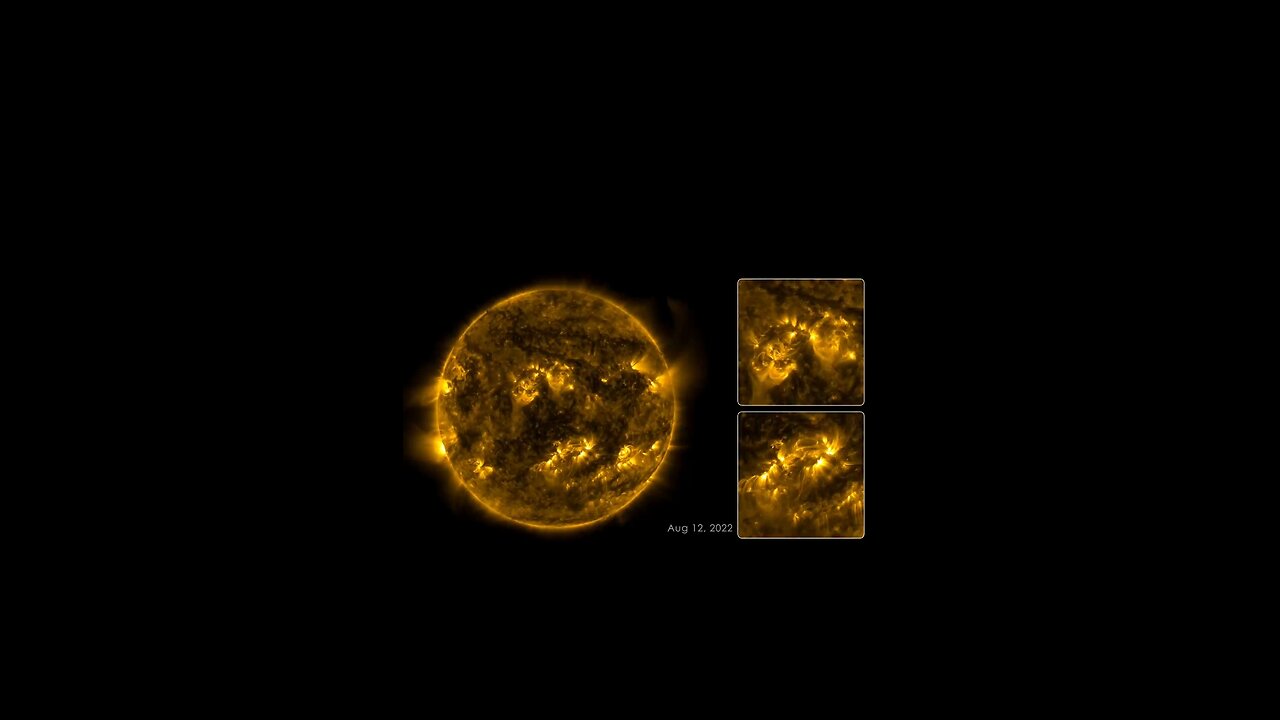Premium Only Content

133 Days on the sun
Scientific Visualization Studio
14266: 2022 Robert H. Goddard Awards
31213: A Smiling Sun
133 Days on the Sun
Released Thursday, January 5th, 2023
Updated Wednesday, May 3rd, 2023 at 11:43AM
Visualizations by:
Tom Bridgman
Produced by:
Scott Wiessinger
View full credits
This 133-day time lapse of the Sun at 17.1nm shows brilliant active regions, dynamic loops of plasma and numerous solar eruptions.
Music (in order): Concave Hexagon, Heptagon, Tetrahedron, Triangular Prism, Square-based Pyramid, Irregular Quadrilateral, Equilateral Triangle, Dodecahedron, Icosahedron, all from "Geometric Shapes" written and produced by Lars Leonhard.Credit: NASA's Goddard Space Flight Center/SDO
Watch this video on the NASA Goddard YouTube channel.
Complete transcript available.
Video Descriptive Text available.
This video chronicles solar activity from August 12 to December 22, 2022, as captured by NASA’s Solar Dynamics Observatory, or SDO . From its orbit in space around Earth, SDO has steadily imaged the Sun in 4K x 4K resolution for nearly 13 years. This information has enabled countless new discoveries about the workings of our closest star and how it influences the solar system.
With a triad of instruments, SDO captures an image of the Sun every 0.75 seconds. The Atmospheric Imaging Assembly (AIA) instrument alone captures images every 12 seconds at 10 different wavelengths of light. This 133-day time lapse showcases photos taken at a wavelength of 17.1 nanometers, which is an extreme- ultraviolet wavelength that shows the Sun’s outermost atmospheric layer: the corona. Compiling images taken 108 seconds apart, the movie condenses 133 days, or about four months, of solar observations into 59 minutes. The video shows bright active regions passing across the face of the Sun as it rotates. The Sun rotates approximately once every 27 days. The loops extending above the bright regions are magnetic fields that have trapped hot, glowing plasma. These bright regions are also the source of solar flares, which appear as bright flashes as magnetic fields snap together in a process called magnetic reconnection.
While SDO has kept an unblinking eye pointed toward the Sun, there have been a few moments it missed. Some of the dark frames in the video are caused by Earth or the Moon eclipsing SDO as they pass between the spacecraft and the Sun. Other blackouts are caused by instrumentation being down or data errors. SDO transmits 1.4 terabytes of data to the ground every day. The images where the Sun is off-center were observed when SDO was calibrating its instruments.
SDO and other NASA missions will continue to watch our Sun in the years to come, providing further insights about our place in space and information to keep our astronauts and assets safe.
The music is a continuous mix from Lars Leonhard’s “Geometric Shapes” album, courtesy of the artist
-
 9:17
9:17
Dr. Nick Zyrowski
1 day ago4 Steps To Lose Fat Naturally Without Exercise
18.1K4 -
 13:10
13:10
This Bahamian Gyal
13 hours agoLooking For A Job in 2025: 10 RED FLAGS To Watch Out For
9.53K5 -
 17:41
17:41
IsaacButterfield
1 day ago $1.36 earnedInsane Woke TikTok Returns Crazier Than Ever!!
7.59K10 -
 8:21
8:21
Mally_Mouse
12 hours agoPresident Trump - Week #2
5.91K12 -
 5:23
5:23
BIG NEM
13 hours agoWhat Is Jollof Rice? West Africans Explain the Magic Behind It!
4.48K5 -
 59:37
59:37
Trumpet Daily
21 hours ago $5.22 earnedTrump Turns Two Weeks Into Two Years’ Worth of Action - Trumpet Daily | Feb. 5, 2025
23.8K50 -
 54:17
54:17
PMG
12 hours ago $0.60 earned"AJ Rice Unfiltered: The Left, the Woke Agenda, and the Death of Humor"
12.1K -
 1:43:11
1:43:11
Omar Elattar
1 month agoFrom Bank Robber To Millionaire: How I Became A $100M Sales Trainer
8.13K1 -
 2:42:28
2:42:28
FreshandFit
11 hours agoShe Dated Him For 2 YEARS Before Finding THIS OUT?!
115K122 -
 2:41:49
2:41:49
Laura Loomer
12 hours agoEP99: Trump Dumps USAID As Leftists Panic!
110K43